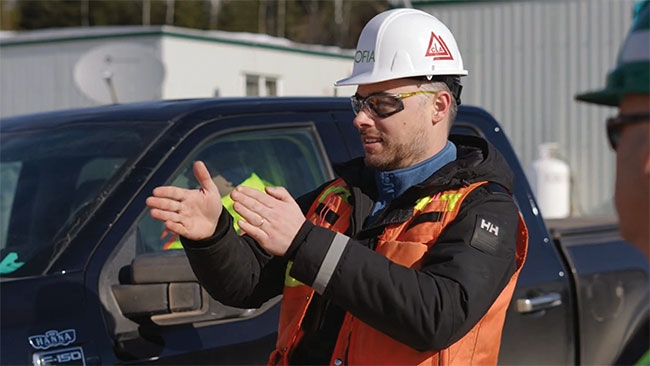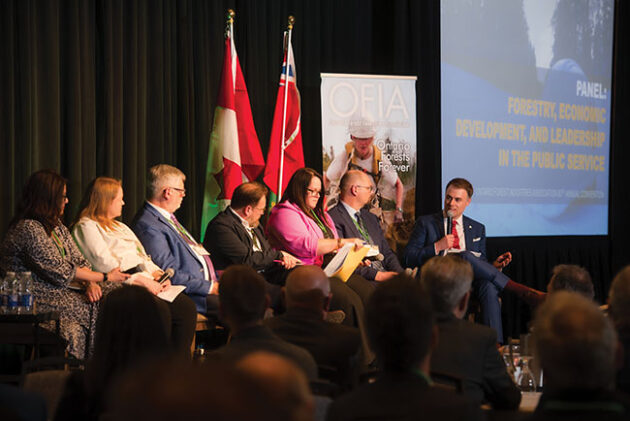
Features
Forests to boardrooms: Q&A with Ian Dunn
August 22, 2023 By Maria Church
 Ian Dunn. Photo courtesy Canadian Wood Council.
Ian Dunn. Photo courtesy Canadian Wood Council. Ian Dunn is here for the forests.
As president and CEO of the Ontario Forest Industries Association (OFIA) for nearly three years, he’s seen more boardrooms than cutblocks lately, but the registered professional forester still takes every opportunity to connect with members on forestry sites across the province.
With the Ontario forest industry poised for growth to meet global demand, Dunn wants to see concrete strides to improve mill and contractor competitiveness in the province.
CFI: What drew you to forestry and what has been your experience helming the Ontario industry?
Forests drew me to forestry. I wanted to do something good for forests – I didn’t really know how to do that or how it would happen. But working with forests, cool equipment, machines, that all drew me in. I grew up in the GTA [Greater Toronto Area], so I had no exposure to forestry whatsoever and knew very little about the opportunities out there. I did an undergrad in environmental studies and in my third year there was a soil science class where we started talking about silviculture. That was interesting. I did a post-grad master’s program at UofT in forestry. That’s where I got started.
When I graduated from school, I wanted a job that was physically and intellectually challenging. This sector turned out to be a perfect fit. The OFIA, at its core, is an industry full of very hard working, committed people. These are the people I represent and it’s been a real pleasure so far. For me, in my current role as president and CEO, it’s not new, I’ve been around the association for quite some time, just in different roles. I’m getting further from the forest, but I still have opportunities to go and meet the members on the ground.
CFI: What are key priorities for the OFIA this year?
The overarching goal for us right now in the association is to see Ontario’s Forest Sector Strategy fully implemented, and to improve the competitiveness of our industry. That strategy was developed beginning in 2018, finalized in 2020, and it was really the result of us looking at other jurisdictions, seeing what they were doing with their resource. Finland had a national forestry strategy that came out in 2015. Their goal was to increase their harvest level from about 60 million cubic meters in 2015 to 80 million cubic meters in 2025. To put it into context, Finland is a third of the size of Ontario, similar forest type and climate, but we harvest about 14 million cubic meters annually so it’s much more intensively driven system.
This sector strategy was developed through lot of consultation, regional roundtables and eventually it was produced and finalized in 2020.
Among a number of goals cited by the strategy is to fully utilize the sustainable annual allowable cut of 30 million cubic meters per year representing a huge growth opportunity for our industry. So in terms of priorities, there’s no easy solution to this, but I would say broadly: improvements to forest road infrastructure, workforce development, carbon pricing, reducing red tape and administrative burden, and market access.

Ian Dunn serves as the president and CEO of the Ontario Forest Industries Association. Photo courtesy OFIA.
CFI: What do you see as the biggest challenge facing the Ontario industry?
If I was to choose a biggest challenge, it’s the cost of doing business in this country. Costs continue to climb for labour, fuel, carbon pricing, truck insurance and licensing, availability of timber, trade restrictions, and the list goes on.
Ontario has made some good strides among our peers in this respect. The curtailments and closures that you’re seeing in B.C. aren’t happening here yet, but we could see these closures if costs continue to climb. We need a policy environment that supports growth in the industry. Too often forest policy is driven by emotion or politics, not always listening to regulated professionals like foresters. All levels of government need to be pulling in the same direction. But there’s also a lot to be very excited about and I am very opportunistic about the future.
CFI: Ontario introduced a nearly $20-million Forest Bioeconomy Program, a first in Canada. What does it mean for the sector?
Across the board, increasing the use of forest biomass is good news for our industry and the sustainability of our forests. Currently, using forest biomass for electricity and energy consumption or production is the most deployable and scalable technology that exists in the industry. There are five facilities in Ontario that use forest biomass to generate electricity that is sold back to the Ontario grid – together generating about 270 MW of power, which is about 300,000 homes. Within our membership there is a significant amount of energy production, producing clean, green energy to the province.
We’ve also seen some really interesting announcements about the use of forest biomass to decarbonize the steel and mining industry here in Ontario. So there’s all kinds of opportunities and emerging products for forest biomass. We’re also seeing the potential for pairing that technology with carbon capture and storage to generate negative carbon emissions. I think that’s really exciting.
The most immediate opportunity is in the form of energy and electricity and I really hope that this fund assists in these types of projects.
CFI: What’s your take on the Ontario forest industry’s social license?
Social license to operate refers to an industry’s level of support by its stakeholders. Using that definition, we work with an extensive network of Indigenous communities, unions, chambers of commerce, and municipalities that are incredibly supportive of this industry and want to see it flourish in Ontario. This support has only solidified and increased over time.
I would say the challenge is that there are some people who read a misinformed or poorly researched article casting the industry in a negative light – or worse, go on social media – and conclude that the industry doesn’t have a social license or it’s weakening. But I don’t think that’s a true measure of what the term social license is meant to capture. It ignores those stakeholders, employees, and Indigenous communities that are incredibly supportive of this industry. They are often just not the most vocal.
As with any issue in this industry, I find the more specific you get the better it is. Does a community have an issue with consultation? Is the community or stakeholder aware of the issue resolution process within the legislation? Is it even a forest management-related issue to begin with? Occasionally some other concerns are brought into the process. Is it road use? Or herbicides? Let’s find out what element is causing the concern and take it from there.
I caution against drawing too many conclusions from the term social license. I think as an industry we need to showcase our work, be transparent and let the work speak for itself.
CFI: What inspires you to continue as a leader in the forest sector?
I said that I got into the industry because of forests, but I stayed in the industry because of the people.
We work with fantastic people with the OFIA. The OFIA team – Lauren, Sarah, Sabrina, Mark, George, and Robert – they’re all incredible resources and so valuable to the industry. I get a lot of inspiration from them.
Mayors, Indigenous leaders, forestry workers, they really are the inspiration. Getting out on the ground with our members, meeting their employees, that really motivates me and the whole OFIA team to deliver and execute. Meeting face-to-face we realize what’s at stake in this industry if we get it wrong.
We’ve also seen some really amazing results of our work at the association over the last couple years, what’s possible, and I want to continue on that momentum. That’s the inspiration for me.
Print this page